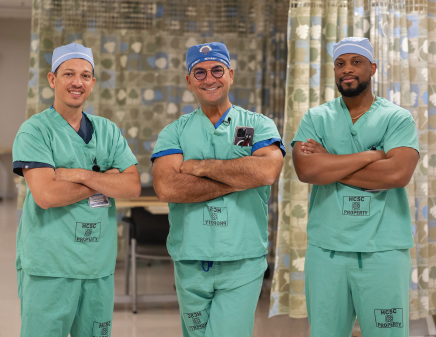“The procedure is a game changer, the result is a life changer”
Prior to hip replacement surgery performed by Kayal Orthopaedic Center surgeon Victor Ortiz, MD at Jersey City Medical Center, Richard Aaron Rosenthal had been feeling the pains of an old man.
Two months after the Mako robotic-assisted procedure, Mr. Rosenthal is pain-free and has regained the mobility of his younger years. “The procedure is a game changer, the result is a life changer,” he says.
Hip pain doesn’t just change the way you move; it also changes the way you think. Richard Aaron Rosenthal discovered this unexpected reality when he finally dealt with pain and lack of mobility from a degenerating right hip joint that had plagued him for years.
“The idea of having arthritis and needing a total hip replacement just didn’t get through to me,” says the 63-year-old business professional based in Long Branch. “I adopted a line of thinking that said, ‘I’m an old man, and these are the pains of getting old.’”
He didn’t realize that a chasm had opened between how he lived—with difficulty walking, getting up from a chair to tackle a chore or tying his right shoe—and how much better life could be.
“You learn coping skills,” Richard says. “I didn’t take medication but devised all kinds of ways to avoid pain. There’s a shift in perception about what’s going on.”
Finally, Richard’s pain notched from seven to 10 on a 10-point pain scale. Previous assumptions—that he had tight hamstrings or needed a chiropractic adjustment and could stretch, exercise or manipulate the pain away—seemed to collapse.
When he got an X-ray, a lack of bone-cushioning collagen in his hip joint was clear. “You didn’t need to be an expert to see I had bone on bone,” he says. “The pain was not going away and would only get worse. The way you fix it is to get a new hip.”
Personalized and Precise
Richard had resisted joint replacement surgery partly out of concern that prosthetic implants might not precisely match his anatomy. Then he heard about the Mako robotic-assisted surgery technology that Jersey City Medical Center (JCMC) recently added to its orthopedic capabilities.
“All of a sudden, surgery made sense to me,” Richard says. “It’s a personalized procedure. I wouldn’t be wondering, ‘How did the surgery go?’ It would go exactly according to a plan drawn up before any incisions were made. That took the worry out of it for me. Robotic- and algorithm-assisted technology was a game changer.”
The Mako system uses imaging technologies such as MRIs or CT scans to create a 3D virtual model of each patient’s unique anatomy. This data is used to create a customized plan, guide bone preparation and precisely position implants during the procedure with help from a robotic arm.
Mako’s precision may help implants last longer, potentially eliminating the need for revisions. Mako patients often experience less pain, reduced stiffness, minimized trauma and faster recovery times.
“The introduction of the Mako robotic arm is a significant milestone in our commitment to transforming orthopedic care in the region,” says Michael Prilutsky, President and Chief Executive Officer of JCMC. “This is another example of how we’re healing, enhancing and investing in Hudson County.”

JCMC’s first Mako procedures were performed by Kayal Orthopaedic Center’s Robert A. Kayal, MD, FAAOS; Victor Ortiz, MD; and Gerald Andah, MD, who have pioneered these cutting-edge technologies in Northern New Jersey.
“We are thrilled to join forces with JCMC in bringing advanced robotic surgery to the Hudson County community,” says Dr. Kayal, Founder, President and CEO of Kayal Orthopaedic Center. “Our goal is to empower patients to make informed choices about their orthopedic care, and, through this partnership, we can extend our expertise to a broader population.”
A New Life
Richard felt relief immediately after Dr. Ortiz performed his total hip replacement in June. “Bone-on-bone pain was absolutely gone,” he says. A pain management program helped him control any postoperative discomfort. “The key is to start moving immediately,” he says.
His daily progress amazed him. “Within a few days, I was walking through Penn Station with a cane and navigating the New York subway system,” he says. He soon began walking unassisted.
Richard continues to strengthen his muscles and says he’s made “a 180-degree physical and mental turnaround. There’s no hesitation to move,” he adds. “Before, I could walk no more than two-fifths of a mile. Now if something is 15 blocks away, I’ll think, ‘Eh, I’ll walk it.’ I’ve lost about 12 pounds just because I’m moving more. It’s a complete reprogramming.”
He now urges anyone with bone-on-bone joint pain to address their quality of life immediately. “Do it now,” he says. “My other hip shows signs of deterioration and might need surgery in the future. I would absolutely get this procedure again. But next time, I won’t wait.”
Pioneering Robotic Technology for Spine Surgery
Jersey City Medical Center is further providing leadership in advanced robotic surgical technology with its use of the Globus Medical ExcelsiusGPS robot for minimally invasive spine procedures. ExcelsiusGPS is the first system to combine a rigid robotic arm with full computer-assisted navigation capabilities into one adaptable platform for accurate spine procedures. CT scans and X-ray images of the spine taken prior to a procedure create a surgical plan that helps the physician guide the robotic arm to a specific area of the spine with high precision. The system is designed not only to improve safety but also to streamline surgical workflow and reduce radiation exposure.
To learn more about robotic orthopedic surgery at RWJBarnabas Health, visit our Orthopedic Surgery page or request an appointment.
